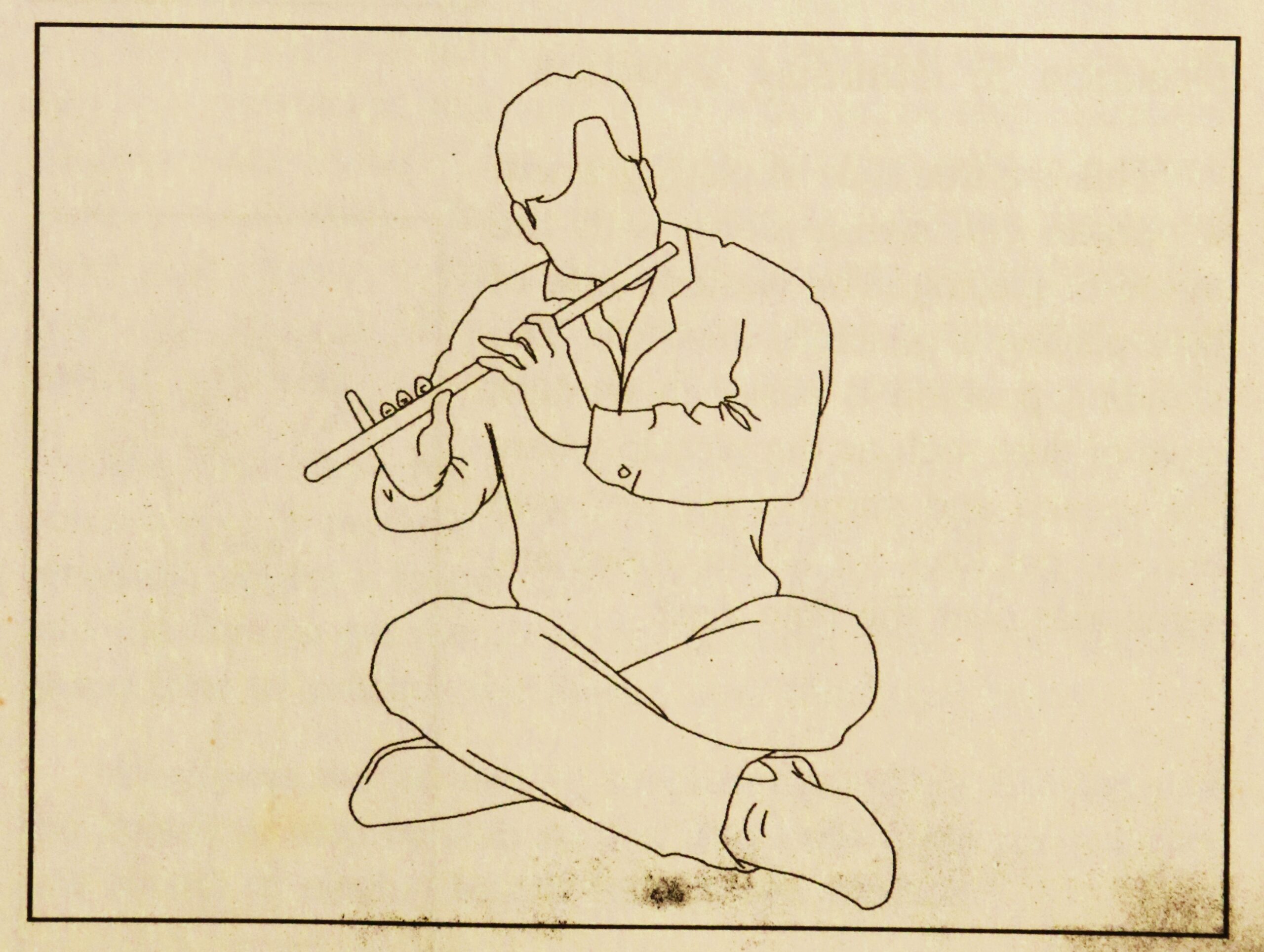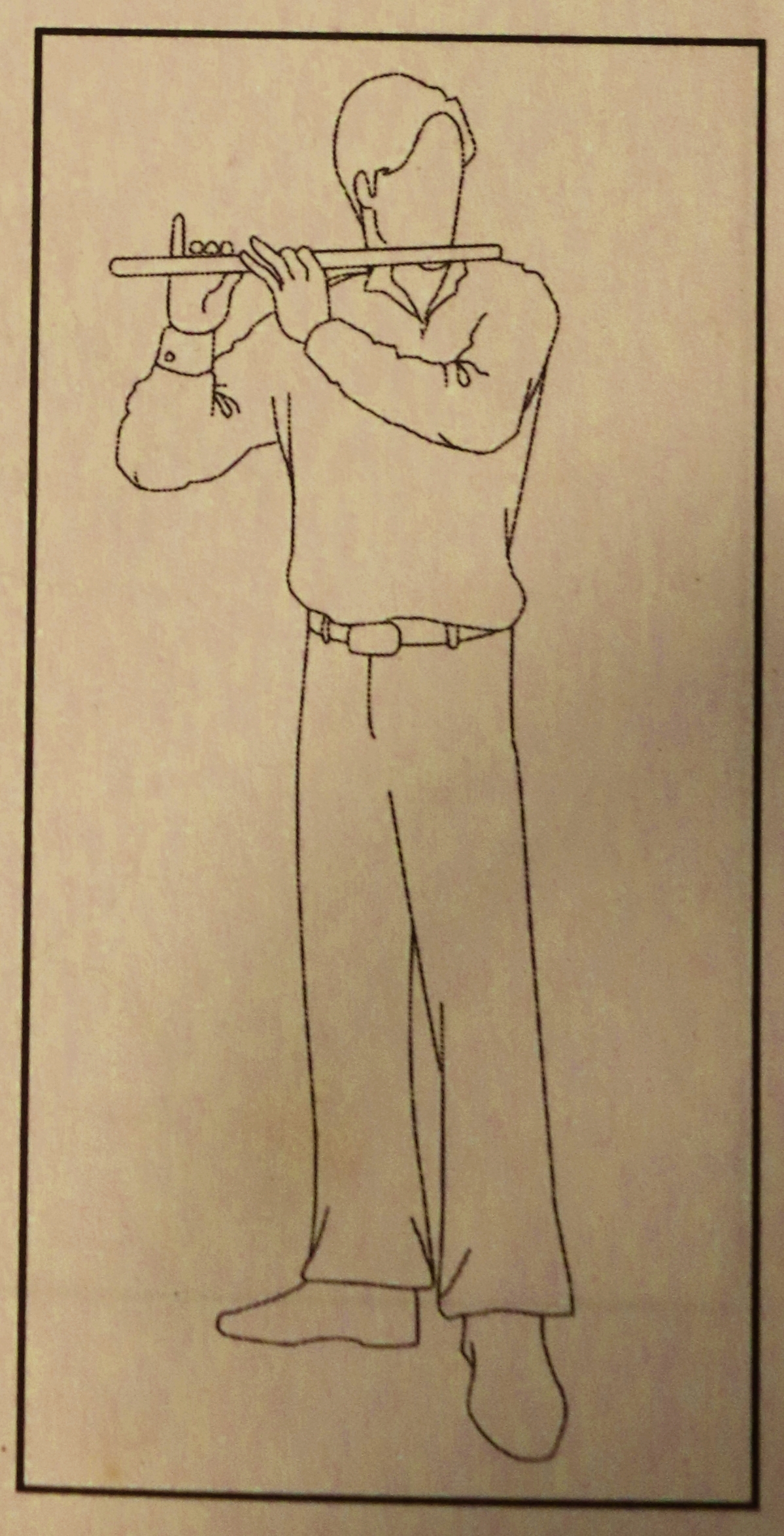Flute
Types of Bansuri (Flute)

- Bansuri Type Flute- This is the original flute of India and is made of bamboo pipe containing 6 holes for the movement of fingers and one more bigger for air from mouth.
- Murali Type Flute- This flute is also made of bamboo pipe. It also contains 6 holes for movement of fingers and one mouth piece with hole for passing air from mouth.
Parts of Flute
- The pipe- This part is made of bamboo or bronze containing various holes as required. The holes of the flute should be in one straight line. The hole through which the air is blown, should be a bit bigger than other 6 holes. The inner part of the flute must be hollow and soft. A cork piece is fixed on the end of the main hole where lips throw air. This cork is meant for producing sound. The inner part should be plane and soft so that it may not put any obstacle to allow the air up to the cork freely.
- The Cork- This is very important part of the flute because the fineness of the sound depend upon the well adjustment of the cork. It is fixed with the upper portion of the bigger hole through which air is blown. If the cork is not well adjusted at the proper place, it is very difficult to play on it, hence the smoothness of the inner part of the flute is very essential. The Murali type flute is not fitted with a piece of cork. A slanting cut wooden piece is placed in such a way that the air from the mouth strikes directly at the body of the flute.
Pitch of the flute
The flutes are of various sizes so they are tuned on different notes. The radio artist keep different numbers of flute with them. The different flutes are tuned on different notes and are played according to the need of the time. One flute cannot solve the purpose of all sorts of sound as some of them are tuned on high pitch while other sat low.

Some players start from second black of Harmonium while others from third, fourth or fifth respectively. Every flute has its own original note. It cannot be changed by the blow of air from mouth. It should be remembered that smaller flutes produce higher pitch while longer one’s produce lower pitch.
Handling the flutes
The Murali type flute is handled in oblique position. The main hole touches the lower lip. The air should be thrown with the upper lip into the hole in such a way that it should directly go in to the main hole. The player should put the lips of the first, second and third fingers of left hand on the hole numbers 6-5 and 4 respectively, while that of right hand on the whole numbers 3-2 and 1. The thumbs of both hands are to be kept just opposite i.e. the lower side of the flute. If there is hole on the back side, use the left hand thumb. The tips of the fingers should be placed on the hole in such a way that they may cover it entirely and allow the air to pass out only through the outlet from which the second is to be produced.

The Bansuri type flute is handled in straight position. So far as its playing is concerned, the player should adjust the fingers and the thumb in such a way that the hole of the out let of air may remain just in front of the mouth. The placing and the movement of fingers is the same as in Bansuri type flute.
The Positions of Playing on Bansuri (Flute)
- Sitting Position on ground.
- Sitting Position on and unarmed chair.
- Standing Position.
Sitting on ground.- It is and ole Indian style of playing on Bansuri and is going on in practice since the time of Sri Krishana in Mahabharat.

Sitting on an unarmed chair.- This style is taken oftenly is some musical conserts. The player takes an easy and convinient position to play on the instrument among his fellow artists.

Standing Position.- This is also an independent style of playing on Bansuri. This player plays on his instrument in free standing style.
Notes on Bansuri (Flute)
The seven full tone notes come out as follows : –
Sa note of Medium Octave on blowing air from mouth and keeping 3 holes
closed from the side of mouth hole.
Re note of Medium Octave on blowing air from mouth and keeping 2 holes
closed from the side of mouth hole.
Ga note of Medium Octave on blowing air from mouth and keeping 1 hole closed from the side of mouth hole.
Tivra Ma note of Medium Octave on blowing air from mouth and keeping all the holes are open.
Pa note of Lower Octave on blowing air from mouth and keeping 6 holes are closed from the side of mouth hole.
Dha note of Lower Octave an blowing air from mouth and keeping 5 holes are closed from the side of mouth hole.
Nee note of Lower Octave an blowing air from mouth and keeping 4 holes are closed from the side of mouth hole.
Sa note of Upper Octave on blowing air with double force and keeping 3 holes are closed from the side of mouth hole. All the other Upper Octave notes can be played by the same method on blowing air with double force.

Half Tone Notes : (Komal Swara).
Half Tone notes are four in number – Re-Ga-Dha-Nee.
There are two methods of playing half tone notes on flute :-
- By keeping the holes half open.
- By changing the position of notes.
According to the first method if we keep the holes of full tone notes half open, the half tone note will come out i. e.- On opening the hole No. 3 half – Re, opening hole No. 2 half – Ga, on opening hole No. 6 half – Dha and on opening hole No. 5 half – Nee will come out.
Method of producing Tune on Flute
Before producing Tune on the flute the following points should be remembered :-

- The tune of the songs should be thought over clearly, because the air is blown in the flute with the stroke of tongue according to the tune of the song.
- The holes of the flute must lightly kept closed as without doing so the sound produced will not be clear.
- At the time of playing half tone and sharp notes tip of the finger should be slightly raised up from the hole. It is the way of half opening the hole.
- Pressure of air from the mouth should be raised gradually in ascend and lowered down in the same manner in descent.
- At the time of playing on oblique flute the angle should be nearly right angle from the face, and when playing on straight flute the instrument should be kept at an angle of about 300 from the chest.
Points for the beginners
- Keep the flute in proper pose and put the complete pressure of the tips of fingers on the holes so that they may keep air in tight position. In big flutes the players use the middle portions of right hand fingers instead of tips.
- Move the fingers in such a way that at the time of removing one finger from the hole the pressure of the next should not decrease.
- The pressure of blowing air should increase in ascent and decrease in descent.
- At the time of practice the pressure of air and the stroke of tongue should keep pace with one another and little by little try to play all the notes in one breathe time.
- When one note is to be played twice, such as SS RR GG etc. they should be played with the stroke of tongue.
- The stroke of tongue should be given on the basis of tune.
- The time and rhythm should always be kept in mind. At the time of practice the stroke of foot is essential at every matra time.